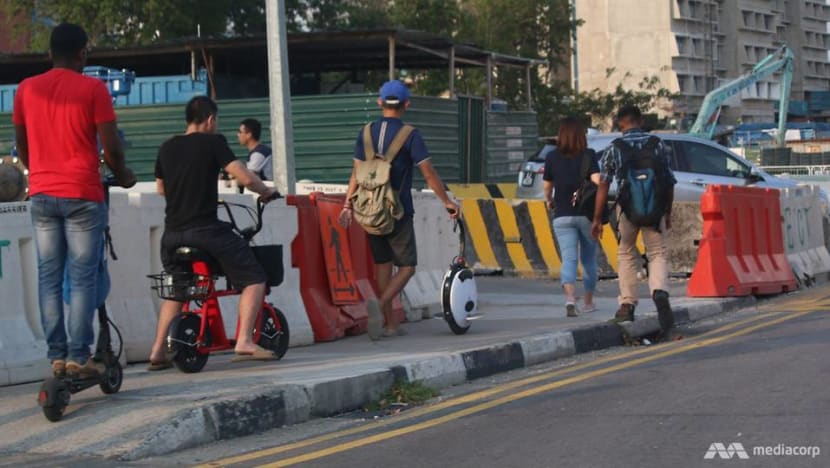Ban on personal mobility devices? 'The battle is always against errant use'

PMD riders near Hougang. (Photo: Aqil Haziq Mahmud)
SINGAPORE: While there are those who support a ban on personal mobility devices (PMDs), others feel that such a move would be an extreme measure.
In Parliament on Monday (Oct 7), Senior Minister of State for Transport Janil Puthucheary said that a ban on PMDs is possible if rider behaviour did not improve.
This marked the first time the authorities had brought up the possibility of a ban, after legalising the use of PMDs on pavements when the Active Mobility Act came into effect last year.
The statement came two weeks after the death of 65-year-old cyclist Madam Ong Bee Eng following a collision with a PMD rider, which Dr Janil said had caused public alarm over the dangers posed by such devices.
RISING NUMBER OF ACCIDENTS IN RECENT YEARS
He noted that the rise in popularity of PMDs had been accompanied by an increase in the number of accidents involving these devices.
Between 2017 and 2018, there were 228 reported accidents involving PMDs on public paths, of which 196 resulted in injuries.
There have been about eight deaths reported in the media resulting from PMD-related accidents since 2016.
However, prior to Madam Ong’s death, these have largely involved PMD riders themselves, who died after either falling from their devices or getting hit by other vehicles.
The increase in accidents here mirrors the situation in other countries.
Earlier this year, non-profit magazine Consumer Report found that more than 1,500 people had been injured in e-scooter accidents in the United States since late 2017, following the emergence of e-scooter sharing firms such as Bird and Lime.
IS A BAN NECESSARY?
In an interview with CNA938 on Wednesday Dr Puthucheary said while a ban could be considered, he does not see it as necessary right now.
Noting the usefulness of PMDs as a mode of transport, he said the Government does not intend to take a “knee-jerk reaction” against a small number of irresponsible riders.

Still, calls to ban the devices persist.
An online petition to ban PMDs and e-bikes here gained traction following Madam Ong’s death, with more than 68,000 signatures as of Oct 10.
Cycling advocate Francis Chu said a temporary ban on the use of PMDs on pavements should be considered.
“I believe a temporary ban of PMDs may be necessary to send a powerful message about the Government's commitment to bring safety back to the pavement,” said the co-founder of cycling group Love Cycling SG.
National University of Singapore transport lecturer Lee Der-Horng also favours a suspension on the use of PMDs here.
While it may sound like an extreme measure, he said the pavements by-and-large are not built to support both pedestrians and cyclists, let alone PMD riders.
“If we allow PMDs on footpaths and public areas, why do we not allow pedestrians to walk on the streets?” he asked.
PMD user Shahrizal Ismail acknowledged while there are some who ride recklessly, the vast majority are responsible riders.
The 37-year-old graphics artist supported stricter regulations, saying a ban would be an imposition on those who depend on PMDs for a living, such as delivery riders.
"The battle is always against errant use," said Mr Denis Koh, the chairman of PMD enthusiast group Big Wheel Scooters Singapore.
"Focusing on the devices will bring errant riding to other forms and it won't stop," said Mr Koh, who sits on the Active Mobility Advisory Panel, which was formed in 2015 to propose regulations on the safe use of bicycles and PMDs here in public places here.
"Soon we will all be walking and believe me, people will still complain how people walk!" he added.
Motorist Au Kah Kay told CNA he has encountered several narrow-misses with PMD riders who zipped onto the road as he was driving.
While the authorities should consider banning the use of PMDs given the rising number of accidents, he said: “But first put in place the regulatory framework - licensing, rider education and third party insurance.”
LOCAL REGULATIONS
In Singapore, PMDs are required to meet a number of requirements. These include a weight limit of 20kg as well as a top speed of no more than 25kmh.
Since July the authorities have also banned the sale of devices that are not UL2272-certified – a set of fire-safety requirements which cover the electrical drive train system of PMDs, including the battery system – as part of efforts to stem the rising number of fires related to their use.
While PMDs that do not meet this standard can still be used for now, they will not be allowed on pavements from July next year.
According to figures from the Singapore Civil Defence Force, there were 49 PMD-related fires in the first half of 2019, compared to 52 for the whole of last year.
E-scooters specifically – defined by the Land Transport Authority (LTA) as PMDs with handlebars – are also required to be registered as part of efforts to deter reckless riding and enhance enforcement, with some 90,000 e-scooters registered with the LTA since the beginning of this year.
READ: Mandatory inspection for e-scooters every 2 years from April 2020: LTA
READ: Major PMD retailers say will not sell devices to people under 16, among other measures
From April next year, registered e-scooters will also be required to undergo inspections once every two years to ensure they meet these standards.
The LTA also conducts regular enforcement activities, impounding devices which do not meet the standards or are found to be ridden recklessly.
In September, enforcement efforts by the LTA turned up 496 offences, with 96 devices impounded.
The authorities are also considering other measures such as mandatory insurance and licensing, as well as restrictions on import.
Still, some questioned how effective such measures are in preventing reckless riding.
Prof Lee suggested the implementation of such measures to deter errant riders may be a waste of public resources. “The effectiveness, in my opinion, will be limited or insignificant,” he said.

THE SITUATION ELSEWHERE
Earlier this year France and Germany said the use of e-scooters would be banned on pavements, citing an increase in accidents.
A number of cities in the United States also restrict the use of such devices to the roads.
In Singapore on the other hand, the use of PMDs such as e-scooters on the roads is illegal, and they are restricted to the pavements.
Mr Chu, who previously sat on the Active Mobility Advisory Panel, said it would be better to restrict the use of PMDs to the roads, as is the case currently with electric bicycles here, whose use is restricted to the roads and shared pathways.
Dr Puthucheary had in Parliament noted that the ideal would be to have one dedicated path for pedestrians and another for cyclists and PMD riders, though infrastructure constraints means there is limited space for such an approach in existing towns.
How pavements are set up here – with cycling paths often right next to pedestrian paths, with little or no differentiation between the two – needs to be relooked, said Mr Chu.
“Compared to the Netherlands, the design in Singapore makes it too easy for people to cycle on the walking path, or pedestrians to walk on the cycling path. We need a kind of barrier to discourage cyclists to use the walking path, at least,” he said.
An “extensive and well-built” network of separate pathways for bicycles and PMDS may be the only way to ensure the safety of pedestrians, who are the primary users of pavements here, said Prof Lee.
Still, even with regulations and infrastructure in place, the onus falls on PMD users themselves to ensure the safety of others, said Government Parliamentary Committee for Transport deputy chairman Mr Ang Hin Kee.
“The regulatory framework put in place by the Government spells out clearly what is expected and provided, but that’s still dependent on users to comply.”














